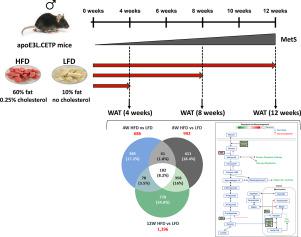Genomics ( IF 3.4 ) Pub Date : 2020-07-08 , DOI: 10.1016/j.ygeno.2020.06.053 Dimitris Nasias 1 , Katerina Dalakoura-Karagkouni 1 , Despoina Vassou 2 , Giorgos Papagiannakis 2 , Ariadni Papadaki 3 , Dimitris Kardassis 1

|
The white adipose tissue (WAT) contributes to the metabolic imbalance observed in obesity and the metabolic syndrome (MetS) by mechanisms that are poorly understood. The aim of this study was to monitor changes in the transcriptome of epididymal WAT during the development of MetS. ApoE3L.CETP mice were fed a high fat (HFD) or a low-fat (LFD) diet for different time periods. Adipose RNA was analyzed by microarrays. We found an increasing number of differentially expressed transcripts during MetS development. In mice with MetS, 1396 transcripts were differentially expressed including transcripts related to immune/inflammatory responses and extracellular matrix enzymes, suggesting significant inflammation and tissue remodeling. The top list of pathways included focal adhesion, chemokine, B and T cell receptor and MAPK signaling. The data identify for the first time adipose gene signatures in apoE3L.CETP mice with diet-induced MetS and might open new avenues for investigation of potential biomarkers or therapeutic targets.
中文翻译:

代谢综合征小鼠模型中脂肪组织的转录组分析确定了与疾病发病机制相关的基因特征。
白色脂肪组织 (WAT) 通过尚不清楚的机制导致肥胖和代谢综合征 (MetS) 中观察到的代谢失衡。本研究的目的是监测 MetS 发展过程中附睾 WAT 转录组的变化。ApoE3L.CETP 小鼠在不同的时间段被喂食高脂肪 (HFD) 或低脂肪 (LFD) 饮食。通过微阵列分析脂肪RNA。我们在 MetS 开发过程中发现了越来越多的差异表达转录本。在患有 MetS 的小鼠中,1396 个转录本差异表达,包括与免疫/炎症反应和细胞外基质酶相关的转录本,表明存在显着的炎症和组织重塑。最重要的途径包括粘着斑、趋化因子、B 和 T 细胞受体以及 MAPK 信号。











































 京公网安备 11010802027423号
京公网安备 11010802027423号